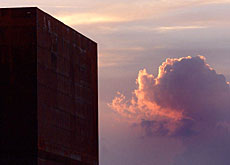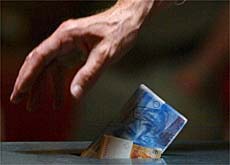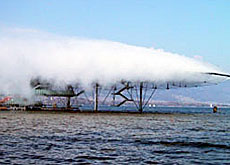Expo entertains but fails to educate

As Switzerland's national exhibition drew to a close, critics broadly agreed that the show was visually impressive but was a little short on substance.
The five-month exhibition, spread around four lakeside sites, has cost the government SFr1.2 billion since its inception four years ago.
Organisers say that by the time it closes its doors to the public on October 20, Expo.02 will have reached its target of about ten million visits.
Despite eventually costing the taxpayer about SFr1 billion, Expo organisers are upbeat about the success of the project.
“It’s not fair to talk about a flop with so many ticket sales,” Martin Heller, Expo’s artistic director, told swissinfo.
“It’s the biggest event this country has seen and its impact on the people will be very long term – even though that alone isn’t enough to pay our bills.”
Lofty ambitions
But Heller admits that the project did fall short of its lofty ambitions.
“Of course, we wanted to do things bigger and better and to have more exhibits, but then again, we weren’t that realistic in the beginning,” Heller says.
“I think our biggest success was to create something that was able to attract such a broad cross-section of visitors.”
During the planning stages of the exhibition, organisers claimed they would redefine Switzerland’s image as part of a conscious attempt to move away from the country’s traditional chocolate box clichés.
They also hoped the exhibition would attract a high number of foreign tourists, but by the halfway stage in July, visitors from outside Switzerland had accounted for only six per cent of ticket sales.
Expo also gained notoriety for the length of its queues, which Heller admits were “embarrassing” but an unavoidable symptom of cost-cutting measures, meaning visitors were flocking to fewer exhibits than originally planned.
Striking visuals
The exhibition attracted the highest praise for its artistic events and for its architecture, which included a giant, rusty monolith on Lake Murten and the futuristic ‘arteplages’ in Biel, Yverdon and Neuchâtel.
“Expo was a success in terms of providing entertainment,” Hans-Ulrich Jost, professor of contemporary history at the University of Lausanne, told swissinfo.
“Artistically, there was a lot of good stuff, although a lot of that was international, rather than Swiss,” he added.
Some critics have voiced concern about the lack of intellectual depth behind the exhibits.
“I think the overall impression was good, but it was more about appearances than content, which was patchy,” says Jean-Jacques Demartines, one of the organisers of Switzerland’s 1968 National Exhibition.
“The exhibits tried to be didactic, but they failed to trigger deeper thoughts about some of the issues they addressed.”
Expo’s most scathing critics say the event failed to address any issues at all.
“Any public relations agency could have staged this exhibition. It had nothing to do with the expression of a national – or even an international – society. There were no ideas, and no unifying concept,” says Jost.
“The organisers demanded a lot of money from the state and then churned out propaganda to force people to attend by calling it a national event – which it wasn’t, because Switzerland’s structure complicates the notion of a ‘national event’.”
Expo’s legacy
Questions also remain over what – if any – imprint Expo will leave on the collective consciousness – and whether it has served to boost Switzerland’s image beyond the country’s borders.
Heller says visitor feedback supports the view that the exhibition is likely to become a “national point of reference” in future, cited during future discussions on what it means to be Swiss.
“Expo was an ironic take on terms like patriotism and nation,” Heller explains.
“We invited people to think about what the word ‘nation’ means in a global world, and in that way we changed the image of Switzerland.”
But Christoph Jaccord, a sociologist at Geneva University, argues that Expo.02 did no more than toy with existing notions about Switzerland, without seriously challenging or deconstructing any of them.
“I don’t think they did anything new,” he says, “they just took advantage of clichéd ideas about Switzerland.”
“It’s really easy to do what they did and they didn’t need so much money do it.”
Mass culture
But Jacques Hainard, curator at the Museum of Ethnography in Neuchâtel, says that while he can understand some intellectuals’ views on Expo, it is important to remember that it was conceived as a popular festival – not high culture.
“One feels good there. The arteplages were welcoming and they are places where you can have a good stroll around. People took great pleasure in the exhibition and so much the better,” he said.
“Expo.02 was a convivial pleasure for millions of people and showed a real audacity in some of its achievements.”
swissinfo, Vanessa Mock
Expo.02 ran for five months – from May 15 to October 20.
The event finished in the red, but it did manage to meet its target of ten million visits.
Critics say the exhibition succeeded in being entertaining but lacked substance.

In compliance with the JTI standards
More: SWI swissinfo.ch certified by the Journalism Trust Initiative


You can find an overview of ongoing debates with our journalists here. Please join us!
If you want to start a conversation about a topic raised in this article or want to report factual errors, email us at english@swissinfo.ch.